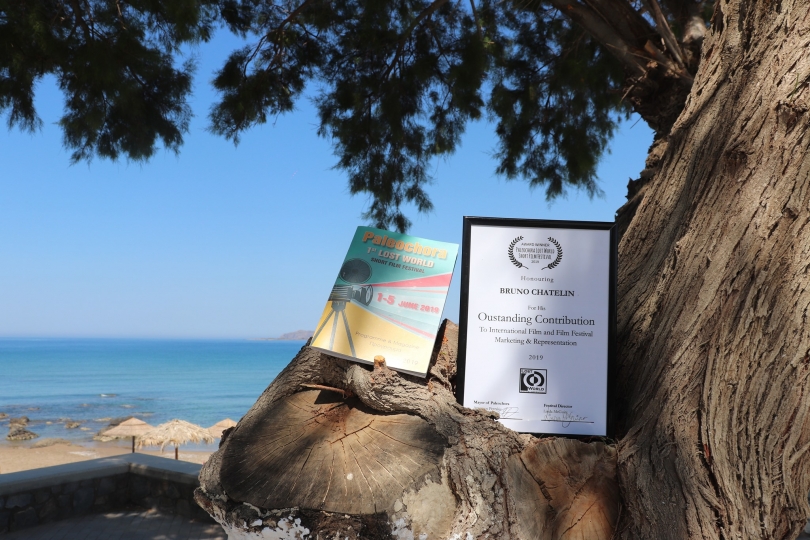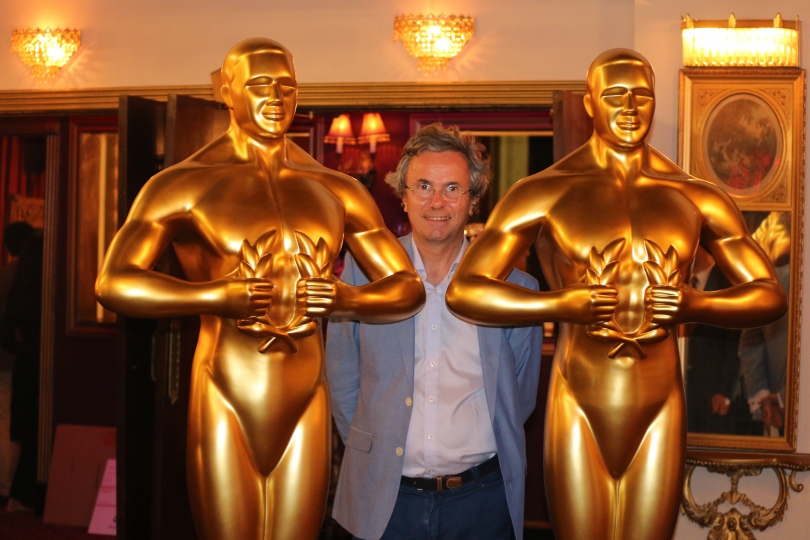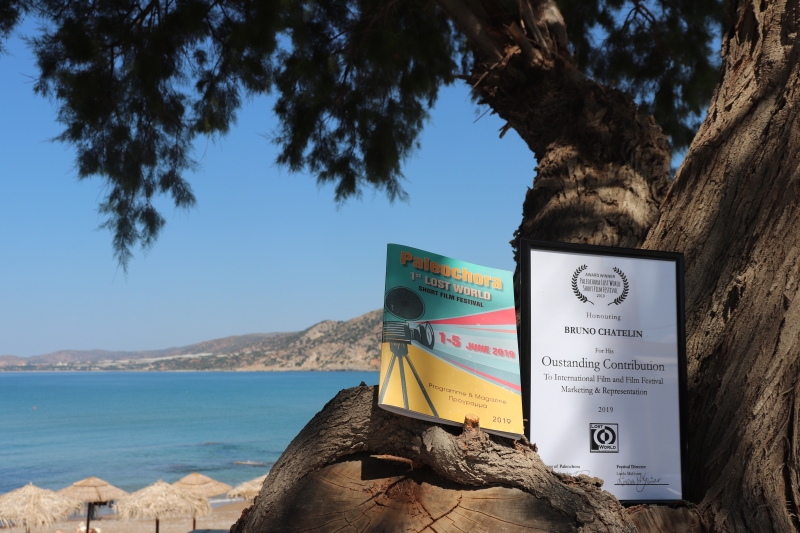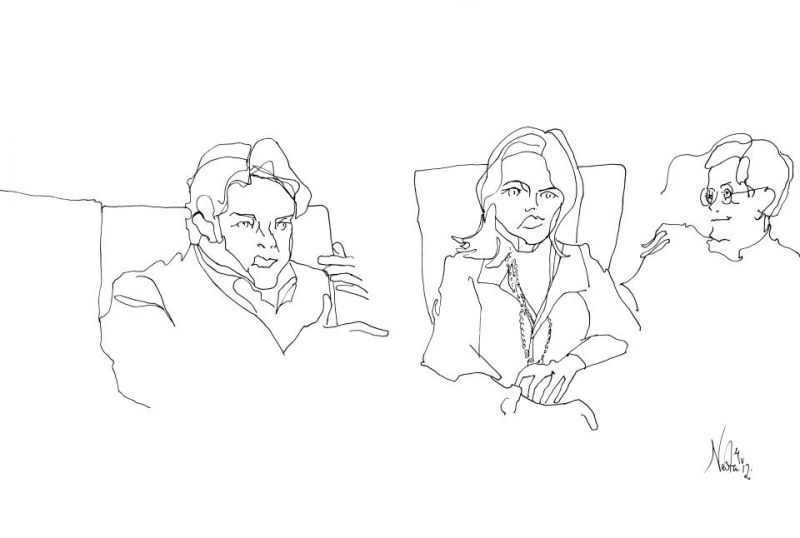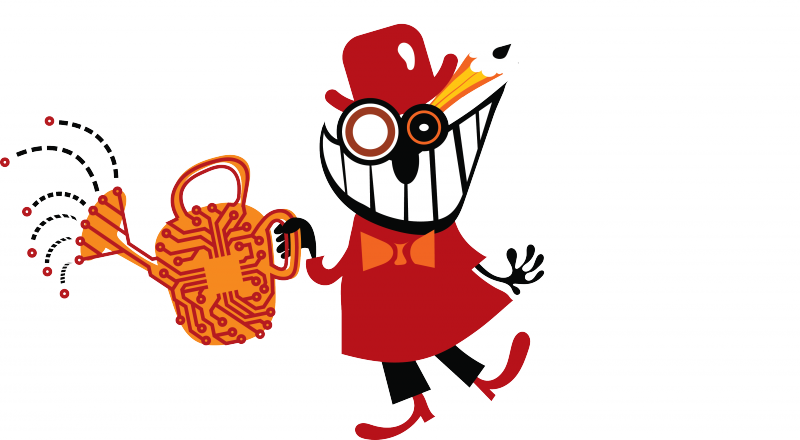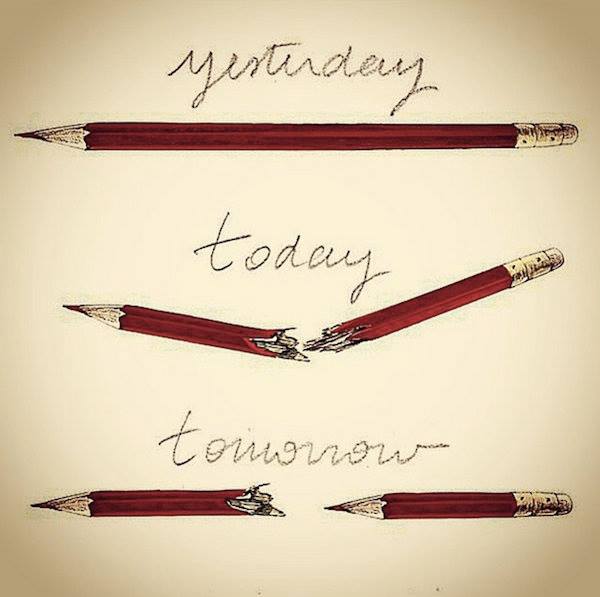"NOIR CITY SEATTLE" OPENS WITH RARITIES FROM THE DARK SIDE OF HOLLYWOOD by Alex Deleon
The traveling all-Film-Noir festival known as "Noir City", introduced personally by the San Francisco based "Czar of Noir", Eddie Muller, opened here at the SIFF theater in the Space Needle dominated Seattle Center on Friday, July 6, with a pair of seldom seen and hard-to-find dark films of the late forties, "Thieves' Highway" (FOX, 1949, 94 minutes) and "Deadline at Dawn" (RKO, 1946, 77 minutes). Both films were shown in pristine 35 mm prints, looking as good now as the day they first came out of the can. One of the hallmarks of this unique Road-show festival is precisely the fact that most, if not all, films are shown in clean thirty-five, or in newly restored prints of films salvaged from oblivion by the Film Noir Foundation, which is the funding organization and brainchild of Mr. Muller himself.
"Theives' Highway" is a memorable Noir of the period, directed by Jules Dassin (of the even more famous New York film noir, "Naked City", and the classic French heist thriller "Rififi", not to mention the very un-noirish "Never On Sunday" of 1962) and stars Richard "Nick" Conte in one of his best roles ever as a novice trucker out to avenge his father's mutilation by mobbish leg-chopping, ably supported, vamped and finally, landed, by postwar Italian star Valentina Cortese, who pumped a little Neo-Realismo into this San Francisco fruit market basher (the all-night market, of course) set in a San Fran waterfront produce market complex that once existed at the foot of Market Street, but is now only a vague memory -- vividly revived, however, in this Dassin landmark.
The film opens and closes on an upbeat note, but all the rest is dark-dark-dark. The opening scene is a pleasant homecoming of son, Nick, back from the wars bearing gifts for the family, but it soon turms dark when the son, Conte, realizes that his father has no feet and that this was done to him by the mob. Whereupon Nick sets out to gain vengeance. In the last scene Conte says to Cortese, "I like the way you wear your hair", as they truck happily southward from The City after many many quirky twists, turns, and punch-outs -- "We'll get married when we get to Tracy" -- which tags an uncharacteristically (for 'noir') happy ending on to this classic of the genre.
The highway of thieves of the title is the treacherous overland route from the fruit orchards of the south to the lucrative (for some people) produce market in San Francisco. The dominating figure of this low-life microcosm is chiseling, treacherous, two faced Mike Figlia -- Lee J. Cobb, in a sneering racketeer businessman role which prefigures his monumental creation of the crooked waterfront tycoon "Johnny Friendly" in "On the Waterfront", the big picture that would cop a basketful of Oscars just a few years later
(1954) -- and, were it not for its prestige cast (Brando, Steiger, et al) and director, Elia Kazan, might easily qualify for inclusion in Noir.
There's no doubt that Mr. Kazan saw Dassin's "Highway" and digested it thoroughly. An interesting side note was supplied by Eddie Muller in his lead-in intro. Richard Conte’s real name was Nick Conte. It was changed to “Richard” for marquee purposes. Then in this film his character is called “Nick”. So, since Nick Conte is the quintessentially Italian actor, why didn’t they just leave it be with “Nick”. That’s Hollywood for you -- first they clean his name up to make it more “Appealing” to the general public, then they always cast him as a tough Dago!
"Noirs" can roughly be divided into two basic categories: Potboiler 'B'
movies made to be seen on Wednesday nights at the neighborhood theaters (which were once everywhere but are now long gone -- and mores the pity) by blue-collar Police Gazette readers (such as my Uncle Nate, ex-Jewish boxer and taproom attendant), with second-rate stars or no-names, and pulp-fiction plots -- and a more polished brand of B+ or A-minus dark thrillers, featuring actors who might also be seen in big-budget 'A' films shown on the weekends, for, (ahem) the whole family. The former category tended to be populated by the likes of Richard Conte, Dan Duryea, Raymond Burr (in his
heavier- than-heavy period, before he became Perry Mason), Steve Cochran, Richard Egan, Brad Dexter, etc., and slinky dames like (The Divine) Lizabeth Scott, the curvaceous Peggy Castle, slinky-dinky Janis Carter, Janet Blair, and a whole host of other floozies, predominantly platinum blondes nobody now remembers. The directors were usually contract helmers, sometimes able craftsmen, but again, long forgotten (who remembers Richard Wallace or Sylvan Simon?) -- except by archivists and historians of the genre. The titles of these throwaway flicks were also more or less interchangeable and are easily confusable among themselves and with other films -- Scarlet Street/Scarlet Letter/Street with No Name, Woman on the Run/Woman on the Beach/Wicked Woman, Desert Fury/Desert Rats -- and so forth and so on.
As the studios began to realize that there was a sizable market out there for hard-boiled thrillers, darker murder mysteries and, of course, sexy dames of little virtue -- now, not necessarily platinum blondes but definitely with a hearts of stone, or harder -- more prestigious directors were brought into the game (or should I say ‘the racket’) after the war -- the likes of Dassin, Phil Karlson, Norman Foster, Edmond Goulding, Lewis Allen -- still not your top-drawer helmers, but respected professionals in the business -- and performers more associated with classy big budget star vehicles -- Dick Powell, John Payne, Franchot Tone, Ann Sheridan, and eventually, really big stars like Joan Bennett, Fred MacMurray, and even a few superstars (before the term was invented), such as Tyrone Power (as the Geek in "Nightmare Alley" 1947 -- arguably, his finest performance ever) and, ultimately, the crowning glory of impossibly beautiful Gene Tierney in "Leave Her To Heaven", 1946. In between are actresses such as Susan Hayward in "Deadline at Dawn" (not to be confused with "Commandos Strike at Dawn") who sashayed right out of this throwaway tongue in black cheek “noir comedy"
to top stardom and an eventual Best Actress Oscar, or Kim Novak's screen debut opposite Fred MacMurray in "Pushover", 1954, who, although she went on quickly from there to top-stardom, had her inherent noirish qualities recognized by Hitchcock when he cast her opposite James Stewart in one of his blackest movies, "Vertigo".
The selection being offered here in Seattle during this post July Fourth week has been carefully culled by Mr. Muller and his partner in celluloid crime, Anita Monga, to present examples of every type of film noir from the most obscure such as "Pushover", 1954 -- (RARITY!!! Never on VHS or DVD!) -- not to mention the debut of Kim Novak, to the lavish 1946 Twentieth Century Fox Technicolor production "Leave Her To Heaven", starring the ethereally gaspingly beautiful Gene Tierney as the over-possessive wife of a wimpishly long-suffering Cornell Wilde, in which she adroitly murders his brother (letting him drown while she looks the other way -- shades of "A Place in the Sun"), "pre-murders" his un-born son in her belly by letting herself "trip" at the top of the stairs (a marvelously acted and directed breath-taker of a scene), and finally "murders herself" with poison to get even with her beautiful sister (Jeanne Craine) by making it look like Jeanne, who has had dove eyes for Cornell all along, look like the culprit, thereby hoping to commit another murder from beyond the Crypt! Never before in all of film history has one insanely murderous bitch been so breathtakingly beautiful.
The director was John Stahl, and this was one of the biggest box-office hits of its year. Although I have to agree with the Noir City program notes which describe "Heaven" in these terms: "Don't let the Technicolor gloss fool you -- this big-budget melodrama is black at the core, as perverse and malignant as it got in the 1940s..." – I still harbor some degree of reservation with regard to calling it a "film noir". The obvious reason is that, in my book at least, film noir cannot, by definition, include lavish big-budget productions with top box-office stars aimed at the mass market...
Otherwise, one would have to include almost all of Hitchcock, films like "A Place in the Sun", or even "Duel in the Sun" (as a "Western Noir"), and/or so many others that the "noir" definition would become too grey around the edges and. ultimately, meaningless. Basically, gimme them crisp black and white, hard edge, night in the city, perverted thrillers with lesser known slinky blondes -- (make that Platinum, please!)-- like Lizabeth Scott, Janis Carter, and the Evelyn Keyses...but, Okay -- for "Leave Her To Heaven" I'll make an exception!
A quick overview of the remarkable films seen here so far: Note, incidentally, that every single one has at least one outrageous blonde bitch (sometimes several) and one major sucker who falls into her clutches, whether he likes it or not – PS – He usually does. The sucker or fall guy, usually does survive – barely – and gets the “good gal” – if there is one…but not before going through some real living hell!
“Thieves’ Highway”, Fox, 1949, 94 min. Directed by Dassin, who later married Greek actress Melina Mercouri, and is still alive somewhere in Greece. Great cast, gripping throughout, and weren’t we all glad when Conte finally deleted his squeaky clean, money-grubbing, suburban fiancée (Barbara
Lawrence) for horny, earthy straight-from-Italy Cortese. (reportedly, also still alive in Italy) even though Valentina was a unabashed lady-of-the-night and, worse, working for that dirty lout, Lee J. Cobb.
Stellar cast includes Morris Carnovsky as Conte’s footless father, Jack Oakie (Mussolini in Chaplin’s “The Great Dictator”, Joseph Pevney, as Oakie’s mousy trucker buddy, (Pevney later became a director of a certain second-rank note) and especially, Millard Mitchell, as Conte’s somewhat shifty trucking partner, who gets burned up in an accident on the deadly highway. Millard was that tall gangly blue-collar wise guy with the Bronx accent you saw in a million pictures but never remembered his name. A memorable no-name character actor if ever there was one. Odd note: In the early fruit orchard scene, the apple orchard couple are Polish and speak clear, unsubtitled Polish! When we see their truck pull away it’s marked “Polansky”. That alone could make this one go over big in Warsaw.
“Deadline At Dawn”, RKO, 1946, 77 min. This one stars Susan Hayward in a tightly clinging black summer dress throughout. That alone is enough to reward any red-blooded male viewer, but this film has some of the weirdest dialogue and shenanigans of any noir ever. Directed (his only film) by theater director Harold Clurman, he and his staff clearly had their tongues solidly in cheek throughout. The basic premise of an impossible naïve and stupid sailor on leave and getting himself involved in a weird murder which must be solved before dawn – when his leave is up – or else, is already borderline ridiculous. The dumb sailor is played by a guy called Bill Williams, who is so convincingly dumb that’s it’s no wonder he never got another job. But he did get Susan at the end-- or was that the other way around? And guess who dunnit – no, not the butler, but the central European cab driver from “Watch on the Rhine” – Paul Lukas! –Aw shucks – there I’ve gone and given the whole plot away, but believe me, this one is so weird it doesn’t matter. In any case, “Deadline at Dawn” is in all likelihood the only Noir “comedy” ever, and worth seeing on those grounds alone --- and then there’s that scrumptuous Susan Hayward..
“Pitfall”, 1948, U/A, 86 min. and “Desert Fury”, 1947, Paramount. 96 min.
Both of these star the divine Lizabeth Scott, who is to my little B mind the quintessence of Film Noir Star – the ultimate mixture of clothes-horse class (she started out as a model) ambiguous sexuality (she was reputed to be a Lesbian, but who cares?) hard-edge self-serving vampishness, occasional vulnerability (as in Desert Fury) and all topped off with the perfect head of long wavy natural (?) platinum blonde hair – at least on her it LOOKED natural. In “Pitfall” Liz lures happily married insurance exec Dick Powell out for a ride in her high powered motor boat, and then it just swirls from there. She will easily extract him from his solid suburban marriage and get him involved in all kinds of nasty shit, poor guy. But then there is this thuggish private-eye – an absolutely massive Raymond Burr – with a back as wide as barn side – who decides out front that Liz is for him, not that philandering Powell, whether she likes it or not. Talk about sexual harassment, but Liz knows how to take care of a monstrous mug like this – with gun in hand, and you better believe it! In the brutal competition for who gets to make it with Liz, first Raymond ambushes Powell in his own garage and beats the shit out of him, but in a return match (not very
believable) soft-guy Powell remembers how to be hard and punches Burr’s lights out in a doorway surprise attack. Plot? –Whattsa difference – yeah sure, Powell gets accused of murder and all that, but what matters is that this is Noir City all the way. Grip your seatbelt and enjoy –or else…
In “Desert Fury” which is shot in color in a desert town somewhere near Las Vegas and introduces Burt Lancaster as the lantern jawed no-nonsense town sheriff – Liz is again, well – sumthin’ else! First of all she lives with her mother (Mary Astor of Maltese Falcon fame) but is this really her mother ? -- (it turns out not, if you actually concentrate on the plot) – or her older Butch lover? -- We’ll never quite know except for that kiss on the mouth at the end as Mary gives Liz and Burt her blessing on the bridge where Liz’s real mother was killed somewhere in the dark past. Then there’s this odd couple, notorious big time gambler John Hodiak (very hoaky, to say the
least) for whom Liz falls at first bite much to Burt’s discontent, and his long-term live-in side-kick, Wendell Corey, who is so possessive about Hodiak that we might just begin to wonder what’s been keeping them together all these years – besides partnership in crime. Eddie Muller calls this the “gayest film noir ever” and he may have something there, but sexual preferences, implied or expressed, aside, this is one hell-of-an enjoyable ride through the desert – in a real wood sided four-door Chrysler Town-and-Country convertible yet!
As for the debut of Lancaster, most “reliable sources” list “The Killers”
(1947) as his first film, but Muller points out that “Desert Fury” was actually shot earlier, although it was, for whatever reasons, released later. Thus, this is really the first film Burt ever acted in, (although not the first he was seen in) and, no doubt about it, he immediately demonstrated star quality. However, since he was already an overnight star from “Killers”, when “Fury” was releases soon afterwards, he received top billing, his name appearing in the opening credits on the same screen with
Mary Astor, Liz Scott and John, Hodiak. This film also introduced Wendel
Corey, a beady eyed actor who would soon become a menacing presence in all kinds of flicks, usually high quality ones.
“99 River Street, United Artists, 83 min. (Rarity, never on VHS or DVD) This one is a doozie in which John Payne, by then an actor of considerable stature albeit an underrated one, comes through big-time as a washed-up boxer framed for the murder of his own wife. The director, Phil Karlson, is also one of the most underrated directors Hollywood has ever produced. This unaccountably little known film has everything going for it, including a clearly followable plot! Brad Dexter, the glossy heavy is the archetypal shadowy noir figure and Evelyn Keyes pulls some of the best shtick of her career. The entire supporting cast, impeccable! “ A damn near perfect 1950s crime saga” More on this one next installment from NOIR CITY, Seattle.
"FRAMED", Columbia, 1947, 82 min.
More on this one next time too – But, for now suffice it to say that Janis Carter should get the all-time “Best Actress in a noir film”, in fact, this was maybe, the best role by any female for the entire year of 1947!
Alex, enjoying the darkness,
More to come -- Stay tuned… Or else!

 Chatelin Bruno
Chatelin Bruno 
















